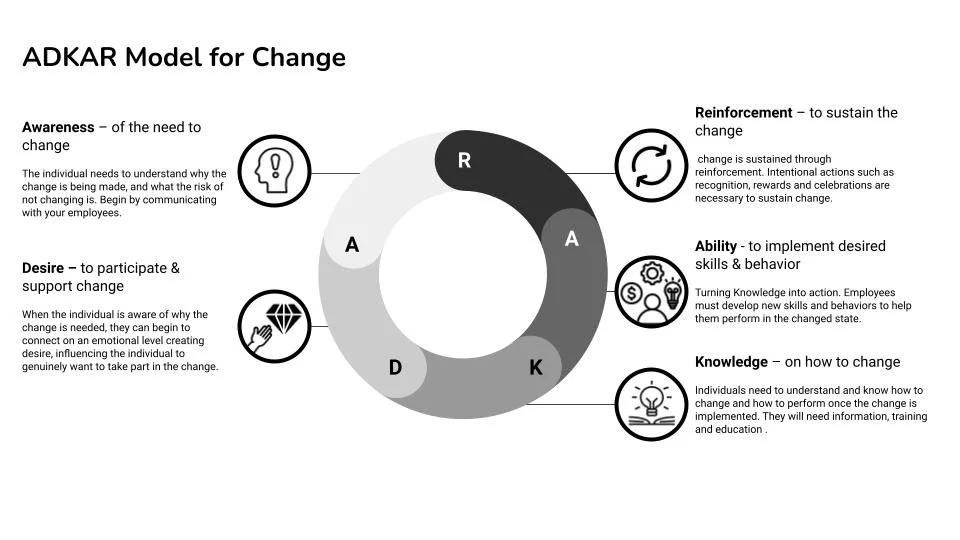Managing through Change: ADKAR Model
As a leader, one of your key responsibilities is navigating your team through change. ADKAR is a change model leaders can use to establish a plan to help individuals move through change successfully.
Tool Summary
ADKAR model was developed by Jeff Hiatt in 1998 to show how change can only happen through individuals. The model illustrates the key concepts that influence successful change and provides actionable insights for implementing these key concepts. The word “ADKAR” is an acronym for the five outcomes individuals need to achieve for successful change: Awareness, Desire, Knowledge, Ability, and Reinforcement.
How to Apply
Awareness:
For effective change, the individual needs to understand why the change is being made, and the risk of not changing. The individual needs to be made aware of the internal and external drivers for change, the benefits of making the change, the “what’s in it for me” argument, and the nature of the change.
Helping your employees understand the “why” is a critical factor in managing and enabling change. It's not enough to just tell your employees what is about to happen. Your employees need to internalize the nature of the change and why the change needs to occur.
Tactics for effectively building Awareness include:
A change communication strategy with your employees- appropriately timed announcement, explaining what needs to occur and why on multiple occasions in multiple formats and forums, and providing opportunities for employees to ask questions and voice concerns.
Strong sponsorship, the primary sponsor of the change is visible and communicates often and effectively with employees about the why of the change.
Coaching by people managers to help team members understand what the change will mean for them in practice and in their day-to-day work. People managers face one of the toughest challenges as they will often be in charge of seeing that the change is actually implemented. For people managers to be able to do this effectively, they need to be equipped with the right information, tools, coaching, and training skills to help their team members implement the change.
Ready access to business information to increase the sense of transparency and keep building awareness on an ongoing basis.
Desire:
When the individual is aware of why the change is needed, they can begin to connect on an emotional level to how the change may benefit them. Creating desire will influence the individual to genuinely want to take part in the change.
Building desire can look like: communicating the benefits of the change, identifying the risks involved, and discussing these openly. Understanding on an emotional level why the change is needed and what the risks of not changing are will help build momentum and a sense of urgency.
Active and visible sponsorship from leadership, frequent communication, proactively addressing risks, engaging employees in the change process, and aligning incentive programs including promotion parameters or pay/bonus scales with project metrics and goals are seen as important tactics to successfully create desire.
Knowledge:
Employees need to be given the information, training, and education necessary to know how to change and how to perform effectively in the future state.
First address the current level of knowledge, capability to learn, and resources available for education and consider what is needed throughout the change.
Next, training and education programs based on the identified knowledge gap should be planned and put in place. Training and education programs can take many forms and should be tailored to take into account the unique change and circumstances, and the needs of the individuals involved.
One-on-one coaching and job aids such as reference guides are effective methods to help translate how to change into how to perform once the change is implemented.
Ability:
Ability turns knowledge into action. At this stage, the change is actively being executed. Employees' ability to develop new skills and behaviors to help them perform in the changed state is put to the test.
Balance a sense of urgency to keep up the momentum, with space and time for employees to feel safe to learn, make mistakes, and try again until new habits, skills, and behaviors are successfully formed.
Managers and change leaders are in key roles- helping to coach, providing resources and tools, and creating time for team members to be able to build these new skills and behaviors.
Support, time, and an individualized approach are considered keys to success at this stage of implementing a change. Managers must be ready and equipped with the time and resources needed to provide one-on-one coaching and feedback in a safe and supportive environment.
Reinforcement:
Change is sustained through reinforcement. This stage is often overlooked though critical to ensuring the long-term success of implementing change.
Like with habits, it takes a long time until new ways of doing things and new behaviors become the new normal. After an initial push, without consistent, ongoing reinforcement of the new behavior, it is easy to revert to old, familiar patterns.
Intentional actions such as recognition, rewards, and celebrations are necessary to sustain change. Reinforcement helps to build positive momentum.
Success feeds success. It's important to seek out wins and celebrate these, especially in the beginning when you are at the most challenging stage of implementing a change.
Other ways to reinforce the change are to use rewards and provide opportunities for employees to voice feedback by using audit and performance systems as well as ensuring accountability systems are put in place. Negative consequences can become a barrier to change. Reinforcement strategies should strive to associate success with progress. When individuals can see the impact of successes, even small progress, the desire to change is reinforced and momentum upheld.
Measuring Results
To measure results consider these questions?
How well do your employees understand and agree with the reasons and ways in which a change is to be made?
How invested in and excited are your team members about the change that needs to be made?
Do your team members feel they know how they are expected to change and perform in the future state?
How well are your employees able to perform in the changed state? Do they feel they are getting what they need to implement the change, and to build new skills and behaviors needed?
Can your employees see how the change is progressing? Do you celebrate wins? Is there a sense of momentum? Do your employees feel committed to the change?
You can survey to assess or observe what is occurring. Are you meeting your goals for the change? Are you retaining your employees throughout? If you are strategic in your change management you should see your goals play out and retain employees or observe continued engagement in the new systems.
Source
Inc., P. (2003). The PROSCI ADKAR® model. Prosci. https://www.prosci.com/methodology/adkar#:~:text=The%20model%20was%20developed%20nearly,change%20leaders%20around%20the%20world.

